Introduction to Naghsh-e Jahan Square
Naghsh-e Jahan Square, with the official name of Imam Square and the old name of Shah Square, is one of the most worthwhile and spelling historical monuments in Persia, It is located in the heart of the olden part of Isfahan City.
City of Turquoise Domes, where you will get to know about Persian art; the art that is left from history, with rolling Turquoise Domes scattered all over the city with grand boulevards, covered bridges, palaces, tiled mosques, and minarets.
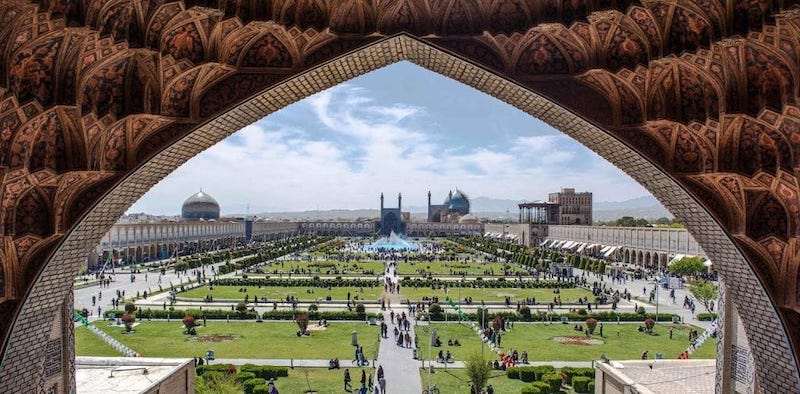
History of Naghsh-e Jahan Square
The history of this square dates back to the Timurid era. Due to political problems, numerous clashes between Persia and the Ottomans, and the geographical location of Isfahan, Shah Abbas I moved his capital from Qazvin to Isfahan. To this end, Sheikh Baha’i, at the behest of Shah Abbas, prepared a new plan for Isfahan, and that square became small in size, expanding to its current form.
Meidan Emam is considered to be the heart of the Safavid government in terms of culture, religion, social power, governance and politics, and many activities of the Safavid era, including army parades, polo games, holding rituals and celebrations and various plays in this place. It shows that this square was also a place for entertainment and recreation for the king, who dominated the whole square above the vast porch of Qapu.
Currently, as one of the most extraordinary historical monuments in the world, it has a special popularity among tourists. The detailed description of this square has been described by famous European tourists who have seen the Persian capital in the Safavid era, such as Knight Chardin of France, Tavernier, Pietro Dolavale, Sanson, Engelbert Kempfer and other European tourists of the Safavid and Qajar eras.
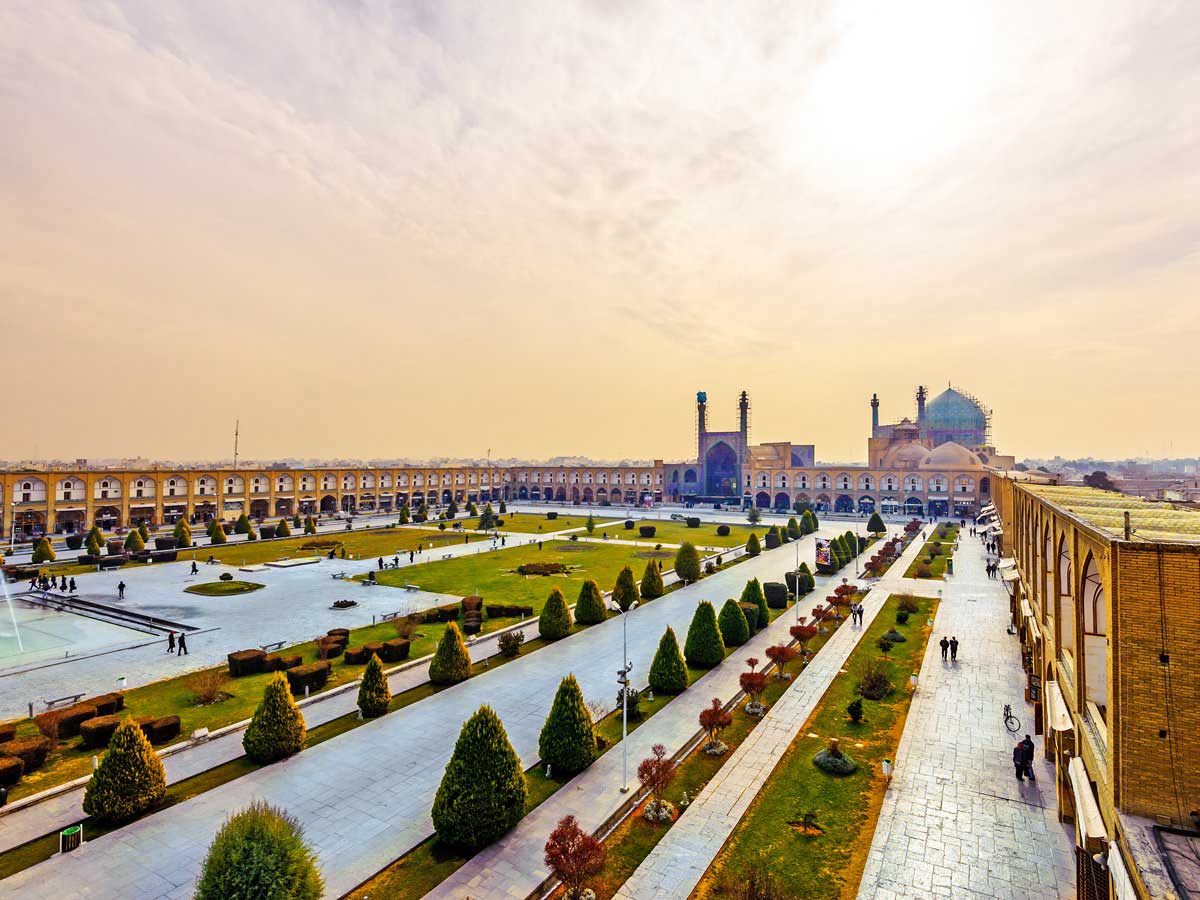
Architecture of Meidan Emam
The most famous and perhaps the most magnificent square in Persia, Meidan Emam, is a complete and perfect combination of Persian architecture and art and all the original structures of this culture. The beauty of this square is its rectangular design, as most are square or oval.
Meidan Emam is larger than Moscow’s Red Square. Moscow’s Red Square is one of the largest and most famous squares in the world. The large, famous square of Brussels, Belgium, has an area of less than one-tenth of the world’s role. The role of the world after Tiananmen Square in Beijing is also known as the world’s second-largest square.
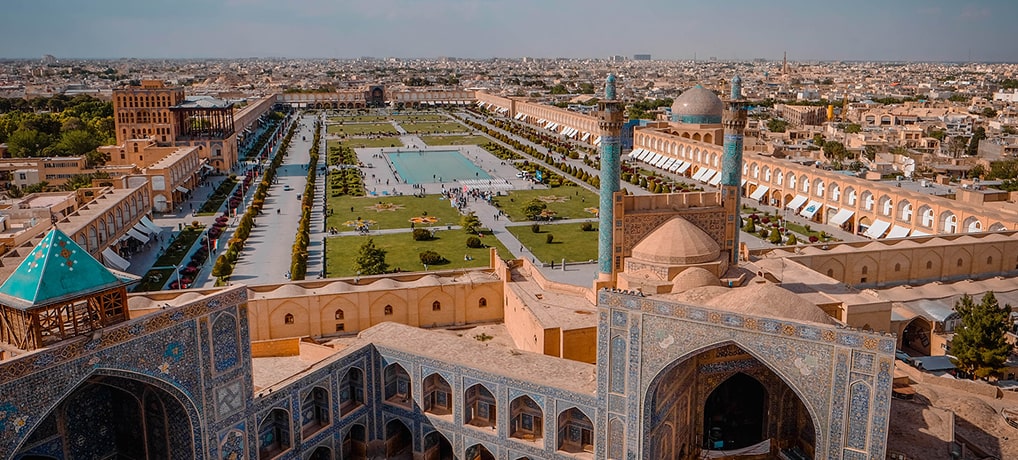
Name of Meidan Emam
Meidan Emam was built on the site of a royal garden called Naghsh-e Jahan Garden. After its construction, it took the name of this garden. Naghsh-e Jahan Square was derived from the name of a square that shone in Tabriz before the capital of Isfahan. Remembering the memory of that square, Shah Abbas ordered the construction of a global role in Isfahan to show the glory and authority of his capital to the world. In the seventeenth century, this square was considered one of the most charming squares in the world, and this description is still valid today.
This mosque is very stunning. The repetition of the building elements, the symmetrical arches, the beauty of the large ablution pool, the tiles, and so on are astonishing. The architect of this building, Professor Ali Akbar Isfahani, and calligraphers such as Alireza Abbasi, Abdolbaqi Tabrizi, Mohammad Reza Emami, and Mohammad Saleh Emami have done the inscriptions.

Ali Qapu Palace, Stunning World Role in Naghsh-e Jahan Square
One of the most spectacular buildings in the world is the Ali Qapu Palace, which is located on the west side and attracts visitors with its charming appearance. During the Safavid period, after the transfer of the capital to Isfahan, by the order of Shah Abbas I, the Ali Qapu mansion was built. The mansion formerly was known as the Mubarak Government. The mansion has six floors that lead to each other with spiral staircases.
The most stunning part of the palace is the last floor bedding, which is known as the music room or sound room, and the role of various instruments can be seen in it. The secret behind the glory of this building lies in its miniatures, which are created by the famous Safavid artist, Reza Abbasi.
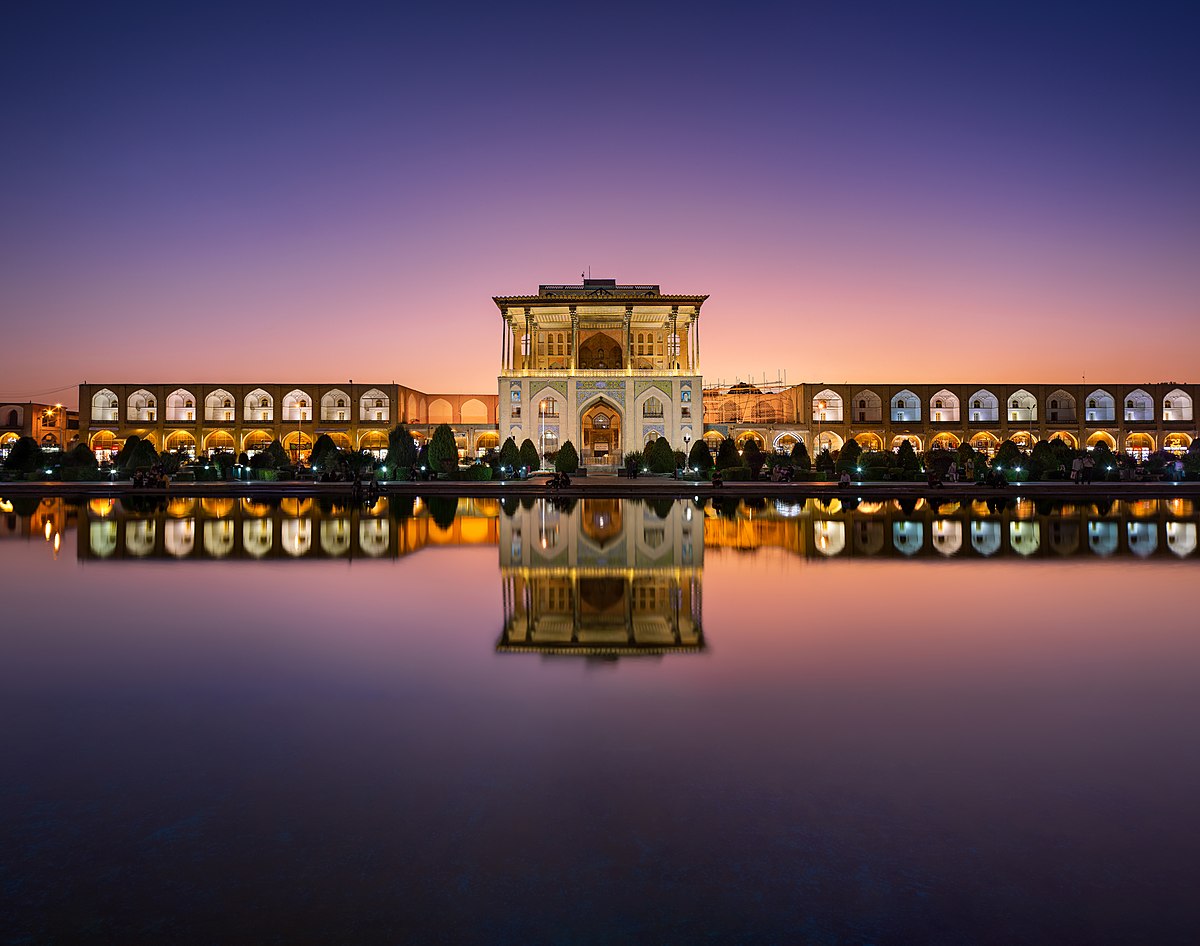
Sheikh Lotfollah Mosque Combining Color and Light
In the corner of Naghsh-e Jahan historical square, a stunning dome attracts every attention. There is no minaret above it, because this mosque has been a place of worship for courtiers and the royal family. A minaret is a symbol of Islamic architecture. It is to invite ordinary people to the mosque; for this reason, there is no minaret in the construction of this mosque. Sheikh Lotfollah Mosque is one of the special mosques in Persia that was built during the Safavid period and today has many fans as one of the sights of the Naghsh-e Jahan complex.
This mosque is located on the eastern side of Meidan Emam and in front of Ali Qapu Mansion. Sheikh Lotfollah Mosque is a masterpiece of architecture and tiling and was built by the order of Shah Abbas, by Master Mohammad Reza Isfahani, one of the famous architects of that period. The construction of this mosque took about 18 years, and after many years, it is still an amazing masterpiece in the use of color and light in architecture. One of the wonders of this building is a peacock that is designed in the inner center of its dome and its feathers are completed by the light entering from the arch above the entrance door of the mosque.
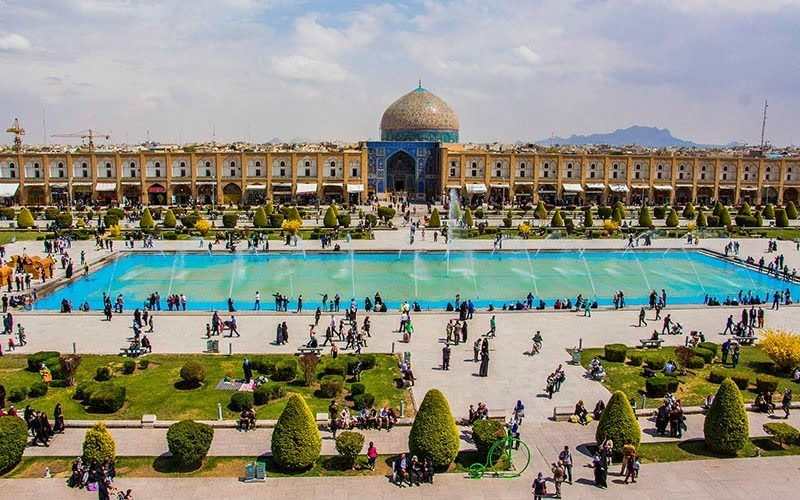
The Royal Mosque (Shah Mosque) in Naghsh-e Jahan Square
On the south side of Meidan Emam, built with charming architecture facing the Qibla, domes and minarets are belonging to the Royal Mosque (Shah Mosque). This mosque, which is also known as Masjid Shah, Soltani Mosque, and Jame Mosque, is one of the most important historical mosques in Isfahan and one of the most important buildings of Islamic architecture in Persia.
This building is a unique masterpiece of architecture, carpentry, and tiles, the magnificent azure, and yellow works that cover the entire mosque. Under the dome, you can hear the reflection of your sound that has amazed all the architects and musicians all over the world. The construction of the Royal Mosque (Shah Mosque) was built by the order of the Shah Abbas, the great began in the twenty-fourth year of his reign.
Its decorations and additions lasted until the time of his successors. The color and size of the entrance and dome of this mosque is very stunning. The repetition of the building elements, the symmetrical arches, the beauty of the large ablution pool, the tiles, and so on are astonishing. The architect of this building, Professor Ali Akbar Isfahani, and calligraphers such as Alireza Abbasi, Abdolbaqi Tabrizi, Mohammad Reza Emami, and Mohammad Saleh Emami have done the inscriptions.

Qeyssariyeh, A Trade Gateway of Meidan-e Emam
Qeyssariyeh Gateway is the name of another structure of the Safavid era that is located on the northern side of Meidan Emam and at the main entrance of Isfahan Bazaar. After facing many events, it still stands firmly in its place. In the past, this building had three floors, but after the destruction of one of the floors, today only two floors of this building remain.
The destroyed floor belonged to the Naqarkhaneh, and music was played at different times of the day. The second floor was for office and business purposes. At the bottom, there was a room for buying and selling. Above the head in Qeyssariyeh are paintings by Reza Abbasi, the bell of Deir Hormoz, and the clock of the Portuguese Castle. This entrance leads you to the noisy corridors of Isfahan’s Grand Bazaar, which is the beating heart of the world’s economy.
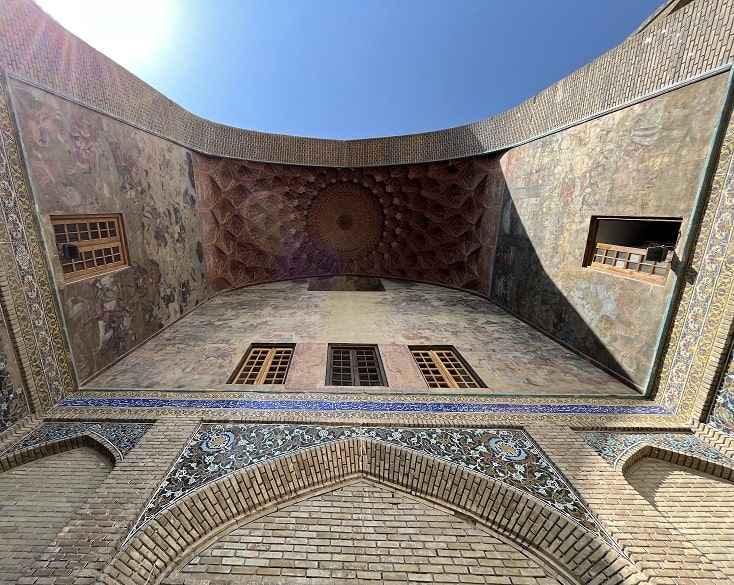
Qeyssariyeh Bazaar, Part of Isfahan Grand Bazaar
Isfahan Bazaar is one of the largest and most fascinating markets in Persia and due to its presence in Meidan Emam, it is one of the most distinguished markets in Persia in terms of tourism. The construction of the main building of this market and its different parts lasted from the tenth to the thirteenth century, and was completed in the Safavid and Qajar periods. The bazaar has a dazzling, breathtaking entrance from Meidan Emam. There are many main and secondary orders in this market, among which we can mention samovar makers, Makhsal, Maghsoud bek, Haruniyeh, Nimavard Golshan, Sheleh, etc. In this complex, religious schools and mosques can be seen like other markets in Persia, some of which are: religious schools of Jeddah, big and small, Nimavar, Haruniyeh, Sadr, bowlers and mosques of Zulfiqar, Jarchi, Shishe, etc.
Gates of Polo Are Forgotten Monuments in Naghsh-e Jahan Square
On the south and north sides of Meidan Emam in Isfahan, there are short and stone columns that have formed the gate of polo and are reminiscent of that game in the past. In fact, these are the oldest polo gate in the world. Naghsh-e Jahan Polo field has been one of the fields for holding polo games, which covers an area of 83,500 square meters, and its design has affected the way polo games are played to such an extent that the fields of world-famous polo are more or less they have taken that pattern. For several years, polo games have been symbolically held in this square to better display the history of this work and make people more aware of it.
The Story of the Jahan Nama Tower in Meidan-e Emam
The work inscribed on the UNESCO World Heritage List is privately owned, meaning that construction is not possible within a certain distance. There is also the issue of cultural perspectives at the UNESCO Summit for such works. In 2002, due to the construction of the Jahan Nama Tower in the cultural landscape of the square, there was a danger for Meidan Emam to leave the UNESCO World Heritage Sites. So as not to damage the cultural landscape of the square.
Naqsh-e Jahan Square is a UNESCO World Heritage
Meidan Emam, which was inscribed on the UNESCO World Heritage List in 1979, still retains its historical splendor and unique architecture and is still the jewel of half the world.
UNESCO World Heritage Criteria of Meidan Emam
Criteria (i): The role of the world, with its description, was built in a short time, according to a coordinated and coherent plan. All the buildings around the square are unique in their kind. The Shah Mosque, located on the north side of the square, has a huge quadrangular entrance with built-in Muqarnas in the middle, and its interior is adorned with delightful glazed tiles. The entrance, which has two minarets, is connected to the south porch by a two-story building.
At the end of this porch is a large courtyard that connects the different parts of the mosque. The whole mosque is built in the direction of the qibla (northeast to southwest) while the direction is the north-south square, and this is one of the strange beauties of Naghsh-e Jahan square. The magnificent Qapu mansion is essentially a unique entrance to the luxurious gardens behind the square. There are many shops around the square, the roof of which rests on 18 wooden beams.
All the architectural elements of Meidan Emam, including the arches, are decorated with glazed and patterned tiles; however, the decorations within the square itself are more visible with trees, flowers, vases, and more. In the meantime, the role of Reza Abbasi’s virtual combinations should not be forgotten. Reza Abbasi was the head of the Isfahan School of Painting during the reign of Shah Abbas Safavid, who is world-famous.
Criteria (v): While most of the urban environments in Persia are very crowded (except for the eco-lodges), Naghsh-e Jahan Square in Isfahan is a unique urban element in Persia. This type of urban architecture is an intended example that is subject to oblivion.
Criteria (vi): Naghsh-e Jahan Square or Meidan Emam is located in the heart of the Safavid capital, It has been used for many purposes, including the departure of the IRGC to the battlefield, passenger accommodation, polo games, ceremonies, and public punishments. The balcony at the entrance of Qeyssariyeh was also a suitable place where music was performed. Ali Qapu Hall is directly connected to the King’s Room, where King Sophra is present. Naghsh-e Jahan Square soon became a cultural and social complex of the Safavid era.
Location of Meidan Emam
Meidan Emam is located in the center of Isfahan and is located in the Safavid government complex, on the east of the square, Hafez Street, and the west of Sepah Street, which ends in the main and historical axis of Chaharbagh Abbasi. Isfahan Grand Mosque is a unique complex that is more than a thousand years old and you can visit Naghsh-e Jahan Square, one of the largest historical squares in the world.
The square is surrounded by the Isfahan Grand Bazaar which connects the 4 magnificent buildings of Sheikh Lotfollah, Ali Qapu Palace, The Royal Mosque (Shah Mosque), and the market of Qeyssariyeh Bazaar. By walking through Sepah Path which is located on the left side of Qeyssariyeh Bazaar, you can reach the Chehelston Garden, one of the royal gardens of the Safavid period and a dazzling, delightful example of Persian Gardens.
When to Visit Naqsh-e Jahan Square
The best season to visit the spectacular city of Isfahan is spring, and traveling in the spring as the most pleasant season of the year can be a good experience for you and we must keep in mind that the best time to travel to the most important civilization in the world would be May.
Where to stay near Meidan Emam
Hozak Home Ecological Resort
The Hozak Home Ecological Resort is one of the native residences of Isfahan Province, which is located on Majlisi Street and hosts a large number of domestic and foreign travelers and tourists every year. This residence is only 300 steps away from the Isfahan Grand Mosque, which is one of the most important and oldest historical sites in the city, so that if you go to the roof of the pool house, you can watch the domes and garlands of the Grand Mosque. Hoodak Cafe also serves a variety of drinks and local food for its guests.
Abbasi Hotel
The luxurious 5* Abbasi Hotel, the world’s oldest hotel and one of the largest hotels in Persia is 300 years old and is located on Chaharbagh Abbasi Street in Isfahan’s Museum City. This hotel was designed and was built in 1106 AH by the order of Shah Sultan Hossein Safavid with magnificent Persian architecture. Abbasi Guest House or Shah Abbas Hotel which is called one of the most glamorous guest houses in the world, if you stay in this hotel, which is one of the tourist attractions of the city itself, you will have a unique experience in the famous city of Isfahan.
Parsian Ali Qapu Hotel
The luxurious 4* Parsian Ali Qapu Hotel, with its appealing traditional-historical architecture of Isfahan, is located in the center of the city and is close to the Royal Mosque (Shah Mosque).
A noteworthy point:
Dear guests,
The hotel is not available, so before arriving in the city center, contact the hotel reception for the necessary coordination.
Isfahan Traditional Hotel
Isfahan Traditional Hotel with its traditional texture and museums like itself, is one of the historical monuments left from the Safavid era with a history of four hundred years, It is in the heart of the historical texture of Isfahan and the proximity of the hotel to Chahar Bagh Street and Meidan Emam are positive points. This is a residence.
Where to eat near Meidan Emam
Shahrzad:
Shahrzad is one of the luxury and old restaurants of Isfahan with its decorative paintings and traditional and stylish mirrors that are worthy of its half-world and crowdedness that shows the quality and good taste of the food. In this restaurant, a variety of Persian and French dishes are served and you can enjoy live music along with your food.
Haj Mahmoud’s brewery:
You can’t go to Isfahan and not try its brewing, especially Haj Mahmoud’s brewery in Isfahan’s Grand Bazaar with a hundred-year lifespan. He walks and has to eat breakfast lightly beforehand or order two for one.
Khan Salar Restaurant:
Suppose you got to the Armenian Alley of Jolfa on the south side of the Zayandeh Roud River. In that case, we suggest the Khan Salar Restaurant, the restaurant of Jolfa Hotel close to the Armenian Cathedral (the alley is like entering into a small town in the heart of a modern city.)
How to go to Naqsh-e Jahan Square
Isfahan is one of the most touristic cities in Persia. To get to Isfahan in a fast and easy way, air travel is the best possible choice. Isfahan Shahid Beheshti Airport (IFN) is the only airport in Isfahan that operates various domestic and international flights.
Also, Isfahan Railway Station is one of the oldest railway stations in Persia and you can easily travel to Isfahan by purchasing a ticket from Tehran. You can experience an exciting trip by car from Tehran to Kashan and finally to Isfahan. Even, you can there to Isfahan by bus. The two terminals of Sofeh and Kaveh are the most important and busy ones in Isfahan.
How to visit Naqsh-e Jahan Square
Go to Naghsh-e Jahan Square or Meidan Emam, sit by the pool in the middle of the square, and enjoy watching the red sunset on the pea dome. The colorful dome of Sheikh Lotfallah. Walk around the square and save the pleasant air of Isfahan with the sound of the bells of the carriages of Naghsh-e Jahan in your lungs. Here is a spectacle of mystery, here is a wonderful history that is tangibly intertwined with people’s daily lives.

